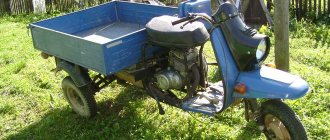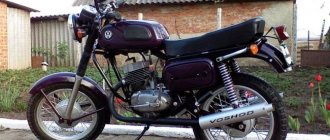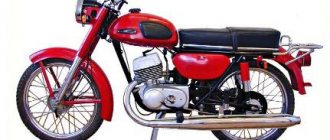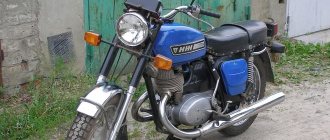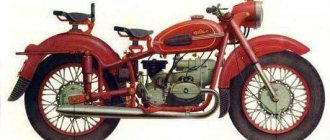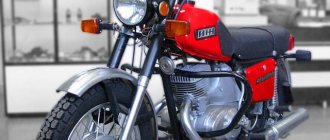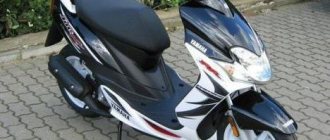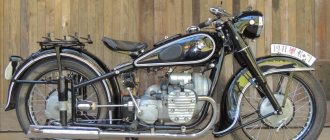In January 1978, from the assembly line of the Tula plant named after. Ryabikov got a new scooter “Tulitsa” (photo below).
True, it can be called new only nominally; in fact, it was a modernized model of the Tourist-M. Even externally, it is quite difficult to distinguish them: additional side engine cooling louvers and the kick-starter pedal, which was now located outside, are, perhaps, the whole difference. As for the “internal” transformations, they were really significant in the car.
Total information
Scooter base, mm – 1400 Ground clearance at full load and normal tire pressure, mm – no less than 125 Overall dimensions of the scooter, mm Length = 2080 Width along the handlebar with mirror, no more than 950 Height – 1200 Weight (dry), kg – no more than 140 Maximum load (including driver), kg – 170 Maximum speed, km/h – no less than 97 Braking distance with full load when driving at a speed of 30 km/h, m – no more than 7.0 Fuel consumption per 100 km at driving at a speed of 45 - 50 km/h on the highway, l - no more than 3.2 at a speed of 73 km/h - no more than 4.5.
Return to content — ↑
New clutch
Along with the updated engine, the Tulitsa scooter also acquired an improved clutch: the old four-disc version was replaced with a six-disc one. Thanks to an additional pair of disks, as well as a damper built into the design, which connected the driven chain sprocket to the drive drum, its overall reliability and durability increased significantly.
It is worth noting that the improved clutch, provided it was equipped with a new cover, could also be installed on older models of scooters from the T-200 series.
Engine
Number of cylinders – 1 Cylinder diameter, mm – 62 Piston stroke, mm – 68 Compression ratio – 66 Cylinder displacement, cm³ – 199 Maximum engine power At 5200 – 5800 crankshaft rpm, l. With. – not less than 14 Maximum torque at 4900 – 5500 rpm, kgf•m – 1.6 Lubrication system – together with fuel Ignition system – battery Carburetor type – KA-36F or K-62G Fuel used – mixture of A76 gasoline and oil M-8V or M-63/10G1 or MS-20 oils Air filter - inertial oil Cooling - forced by fan Starting system: with direct current - dynastarter or kickstarter
Return to content — ↑
Description
The production of the scooter began back in 1979, at the plant named after V.M. Ryabikova. This model “came” to replace the “Tourist-M”. The appearance is in many ways reminiscent of an “older comrade”. But there are still differences. We list them: the external location of the kick starter, the holes provided on the body for ventilation of the internal space. To get a closer look at the equipment, it is recommended to view a photo of the Tulitsa motor scooter.
In terms of technical characteristics, the scooter has improved. Thus, the productive element produces 2 units of power more than the Tourist-M2. The increased power was the result of improved cylinder scavenging and compression ratios. For better thermal conditions, a new cylinder was installed on the new model, and the location of the spark plug was changed to central. The cylinder is fastened using 4 long studs.
Greater power left fuel consumption unchanged. That is, this did not affect the efficiency in any way. There are three rings on the piston (there are 2 rings on the Tourist-M). The roller bearing in the connecting rod was replaced by a needle bearing.
There were some changes to the frame on this model. “Tulitsa” is equipped with a much stronger power frame. This was achieved due to the installation of a new side cross member and reinforced gussets. The engine mount located at the rear has been modernized.
Power transmission (transmission)
Clutch - damper, multi-plate in an oil bath Gearbox - 4-speed Gear shift - foot Gear ratio from engine to gearbox - 2.353 Transmission from engine to clutch - chain type PV-9, 525–1200 GOST 13568=75 50 links Transmission from gearbox to the rear wheel - chain type PR-12.7 1820-2 GOST links Gear ratio - 2.235 General gear ratios of the gearbox: In first gear - 3.000 In second - 1.644 In third - 1.235 In fourth - 0.900 General gear ratios from the engine to the rear wheel: In first gear - 15.777 In second - 8.646 In third - 6.495 In fourth -4.733
Return to content — ↑
Where can I buy Tulitsa?
After 1995, TULAMASH completely stopped producing previously developed motor vehicles, switching to a different type of product. However, lovers of two-wheeled rarities still have the opportunity to purchase a Tulitsa motor scooter. Avito, an online site where individuals post advertisements for the sale of various goods, today offers a fairly large selection of these cars. The price of the model depends on its appearance and general technical condition. If necessary, you can also purchase spare parts for this vehicle there.
In a word, if you want to have a “Tulitsa” in your garage, then it all depends on desire and financial capabilities.
Chassis
Frame - tubular welded Front wheel suspension - long-link with spring-hydraulic shock absorbers Rear wheel suspension - lever with spring-hydraulic shock absorbers, unified with the shock absorbers of the front suspension (except springs) Wheels - detachable, tires with rims are interchangeable Brakes - shoe shoes with a diameter of 150 mm Tire size , inches – 4.00-10 Tire pressure, kgf/cm²: Without a passenger Front wheel – 1 Rear wheel – 1.5 With a passenger Front wheel – 1.2 Rear wheel – 2.5
Return to content — ↑
Other changes in the Tulitsa design
One of the disadvantages of previously produced Tula cars was the not very strong frame. When designing the Tulitsa motor scooter, the designers tried to correct this issue by strengthening it with another tubular cross member and two gussets.
In addition, the side stand also changed its place, “migrating” from the right side to the left.
The transformation also affected the muffler; now it was fixed in two places through special rubber gaskets, which significantly reduced the noise level and increased its service life.
There were also some changes in the wheels: their hubs were combined with brake drums made of aluminum alloy, the use of which reduced the weight of the wheel and accelerated heat transfer. Thanks to this, the braking process has become more effective.
The rim remained detachable as before, only now it was attached to the drum with six bolts, and not four, as before.
To ensure a more reliable supply of fuel, the Tulitsa tank was equipped with a simple pressurization system, thanks to which excess pressure was created in the fuel tank, and gasoline was already supplied under pressure to the carburetor.
Electrical equipment
Electricity source - 6MTS9 12V battery Ignition coil - B51 Dynastarter - DS-1A, power 87.5 W Regulator relay - PP121 Ignition switch - VK330-B Turn signal switch - P201 Light switch with horn button - P25-A Switch - VK26 -A2 Signal - S205B Headlight (optical element) - FG50-G with lamps A12-50+40 and A12-1.5 or A12-1 Capacitor - K42-18-9 Rear light with brake light, lamps - A12-1 , A12-21 Direction indicators, lamps – A12-21 Brake light switch – VK854 Speedometer SP-131 Spark plug – A17B Portable lamp – A12-1 Light breaker RS57-B
Return to content — ↑
Data for adjustments
The owner of Tulitsa should remember or write down the following data:
- the gap between the breaker contacts should be in the range from 0.4 to 0.7 mm;
- the gap between the electrodes of the spark plugs should be maintained in the range from 0.5 to 0.6 mm;
- free play of the clutch lever varies from 5 to 20 mm;
- the free travel parameters of the lever, but of the hand brake, will be from 5 to 15 mm;
- for free travel of the foot brake lever, the data is 5-15 mm;
- when setting the ignition, the advance indicators to top dead center will be 3.2-2.8 mm;
- on the rear wheel, the sag of the drive chain should be 15-25 mm.
Based on these parameters and data, each Tulitsa owner will be able to set the basic settings with his own hands and ensure the efficient operation of the entire scooter.
Specifications
The successor "Tourist-M" had a more powerful engine. “Tulitsa” became more powerful by two horsepower. And again, as in the case of the previous model, this parameter was achieved by increasing the compression ratio from 7.8 to 9.3.
The increase in engine power was also facilitated by three-channel, more advanced purging in the cylinder. But increasing this technical characteristic led to increased thermal loads. In order to maintain normal operation, the Tulitsa scooter received a new cylinder head with developed side ribs and a central location of the spark plug.
Interestingly, the increase in both the compression ratio and, accordingly, power did not affect fuel efficiency and did not require a transition to a higher octane brand of gasoline. The Tulitsa scooter was still powered by the AI-76. Instead of a roller one, it became a needle one. This design doubled the durability of the crankshaft. As a result, the engine of the Tulitsa scooter, designated in the technical passport as T-200A, received power from fourteen to sixteen horsepower.
The clutch has also changed for the better. Thanks to an additional pair of disks - master and slave, as well as a built-in damper, it has become more reliable. The designers were also able to make the frame of the Tulitsa scooter somewhat stiffer than its predecessor.
The side stand, based on user dissatisfaction, was moved from the right side to the left. The muffler on the Tulitsa scooter began to be attached to the body at two points using rubber gaskets. This has significantly reduced noise and increased durability.
In January 1978, from the assembly line of the Tula plant named after. Ryabikov got a new scooter “Tulitsa” (photo below).
True, it can be called new only nominally; in fact, it was a modernized model of the Tourist-M. Even externally, it is quite difficult to distinguish them: additional side engine cooling louvres and the kick-starter pedal, which was now located outside, are, perhaps, the whole difference. As for the “internal” transformations, they were really significant in the car.
TMZ line
Meanwhile, in the USSR, motor scooters were incredibly popular among the population, almost as popular as mopeds. Soviet industry had something to be proud of. Many large machine-building plants produced motor scooters. In Tula alone, up to one hundred thousand of them were produced per year. “Tourist”, “Tulitsa”, “Ant” - these are only production models, but there were also more than a hundred experimental ones, starting with an amphibious scooter and ending with a scooter called “Dragon”. By the way, the latter was not much different from its modern analogues, with the exception of a two-stroke engine.
"Tourist"
A scooter under such a proud name has been produced at the Tula plant since the second half of the sixties of the last century. According to the creators, it was made for free movement across the vast expanses of the Union. The authors, based on the previous T-200 and T-200M models, created a series that was different in design from its predecessors. Technically, the “Tourist” is a motor scooter, which has become a significant breakthrough in mechanical engineering. It was noticeably different from previous analogues.
The design bureau, which was entrusted with the development of the Tourist, did a great job of improving many of the technical shortcomings of small vehicles produced at the Tula plant.
The new model had a load-bearing hood, which made it possible to eliminate the oversized tubular subframe at the rear of the scooter. And its new lever-type pusher fork provided good handling. According to reviews, this scooter, along with innovations, also had several disadvantages. But overall, the “Tourist” is quite comfortable and reliable. Moreover, at the All-Union motorcycle competition held in 1967 in the “brand championship” category, it was with him that he was awarded the main prize and overall first place. Two years later - in 1969 - this success was repeated. Among the production models, the Tula “hard worker” took second place.
